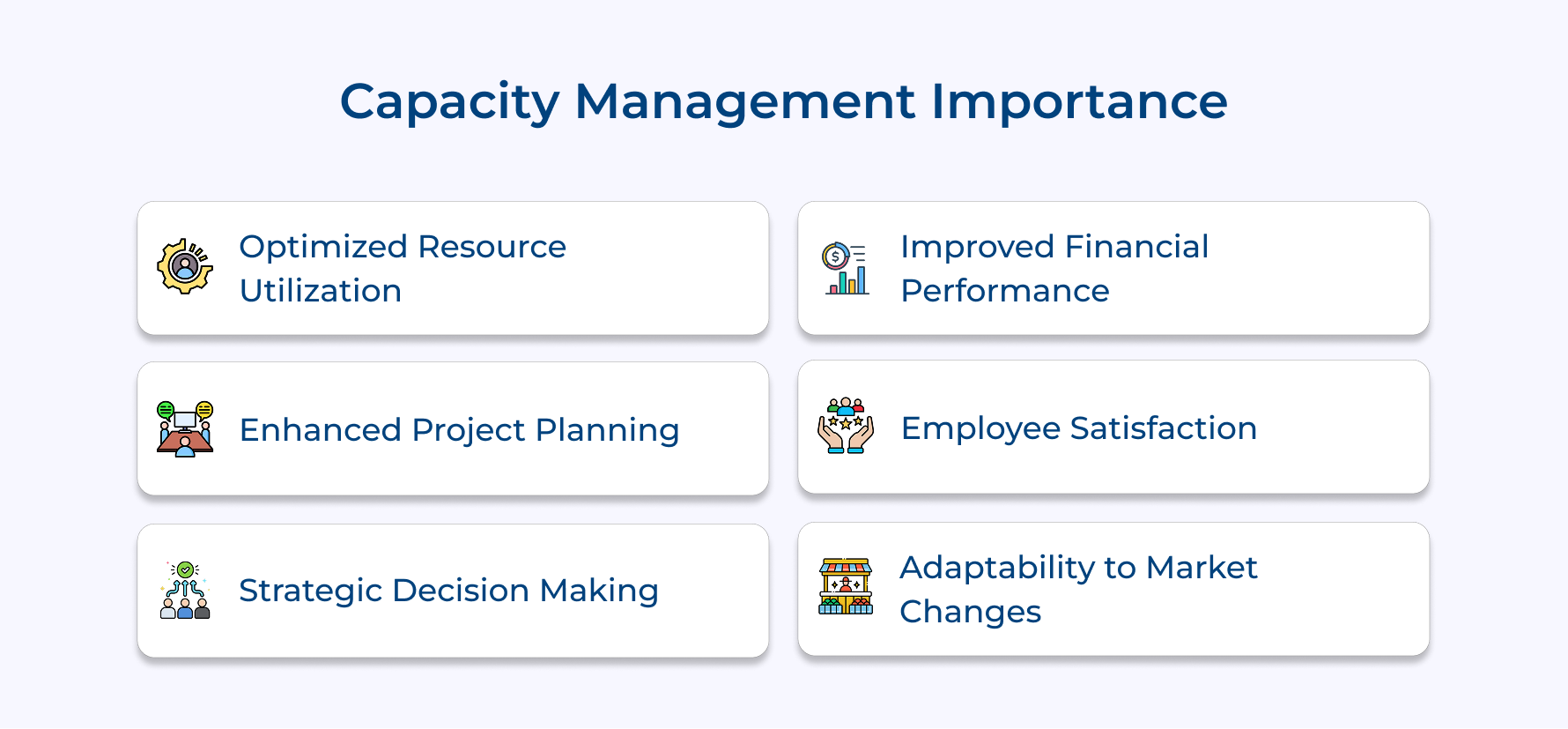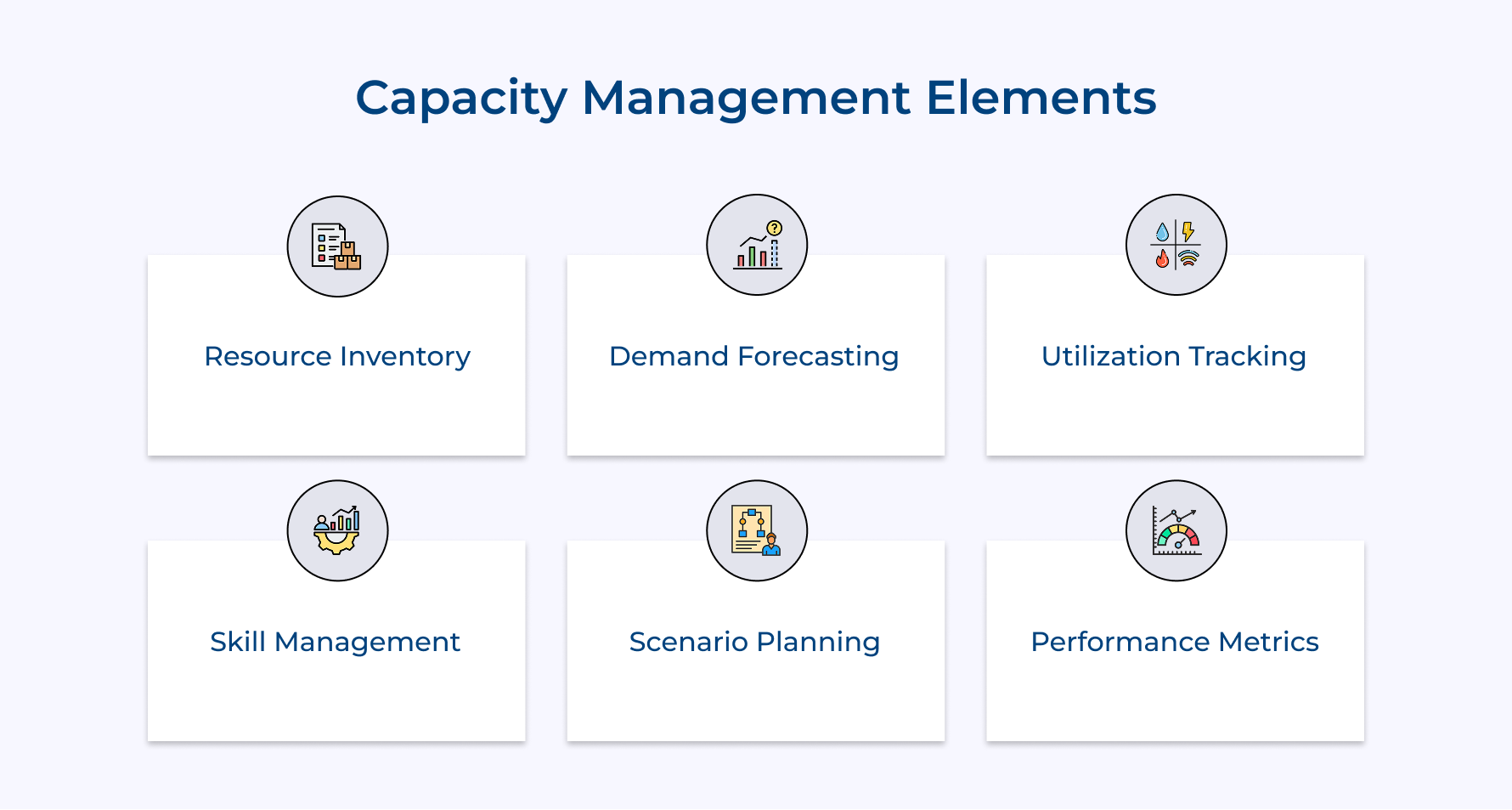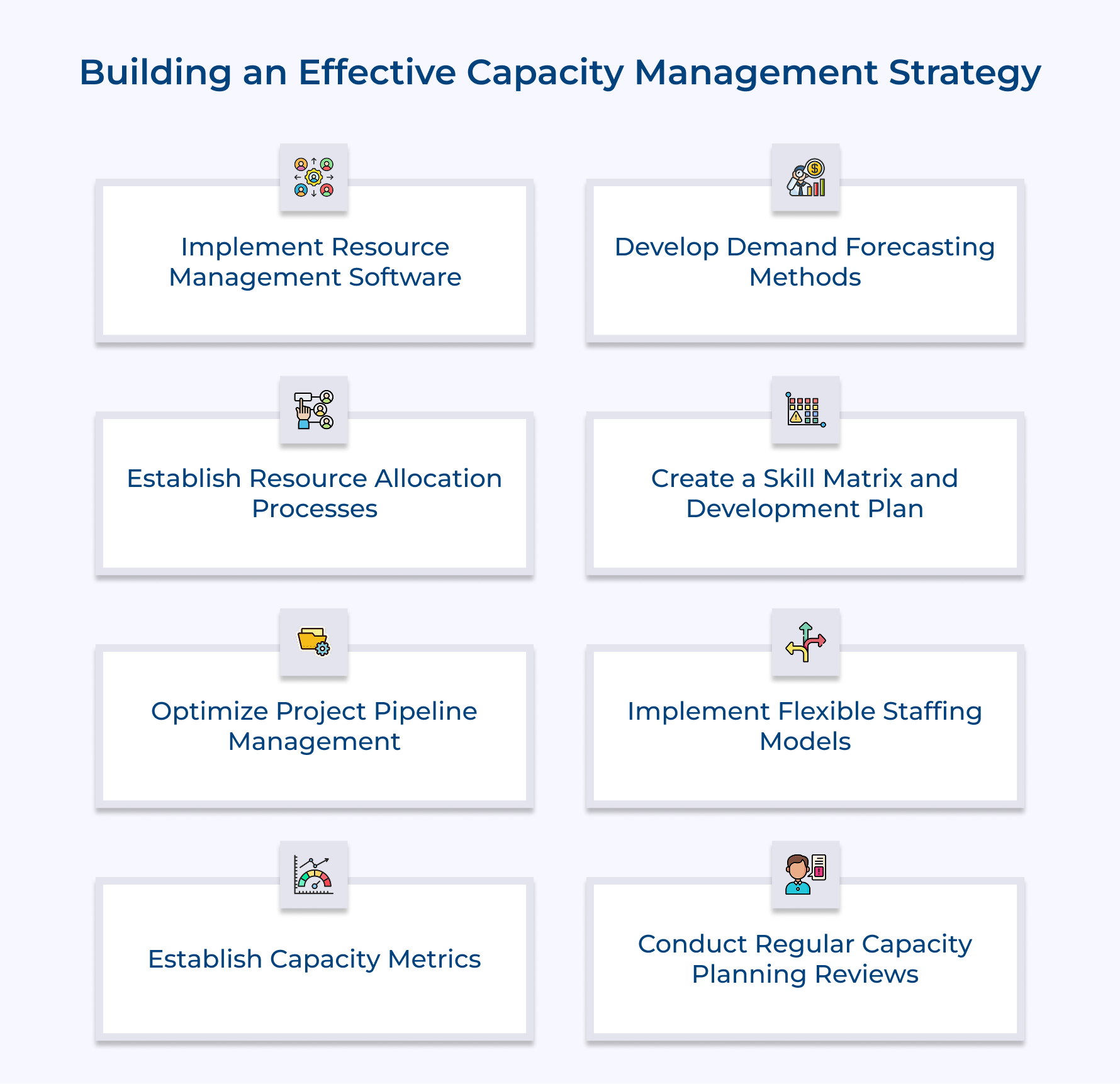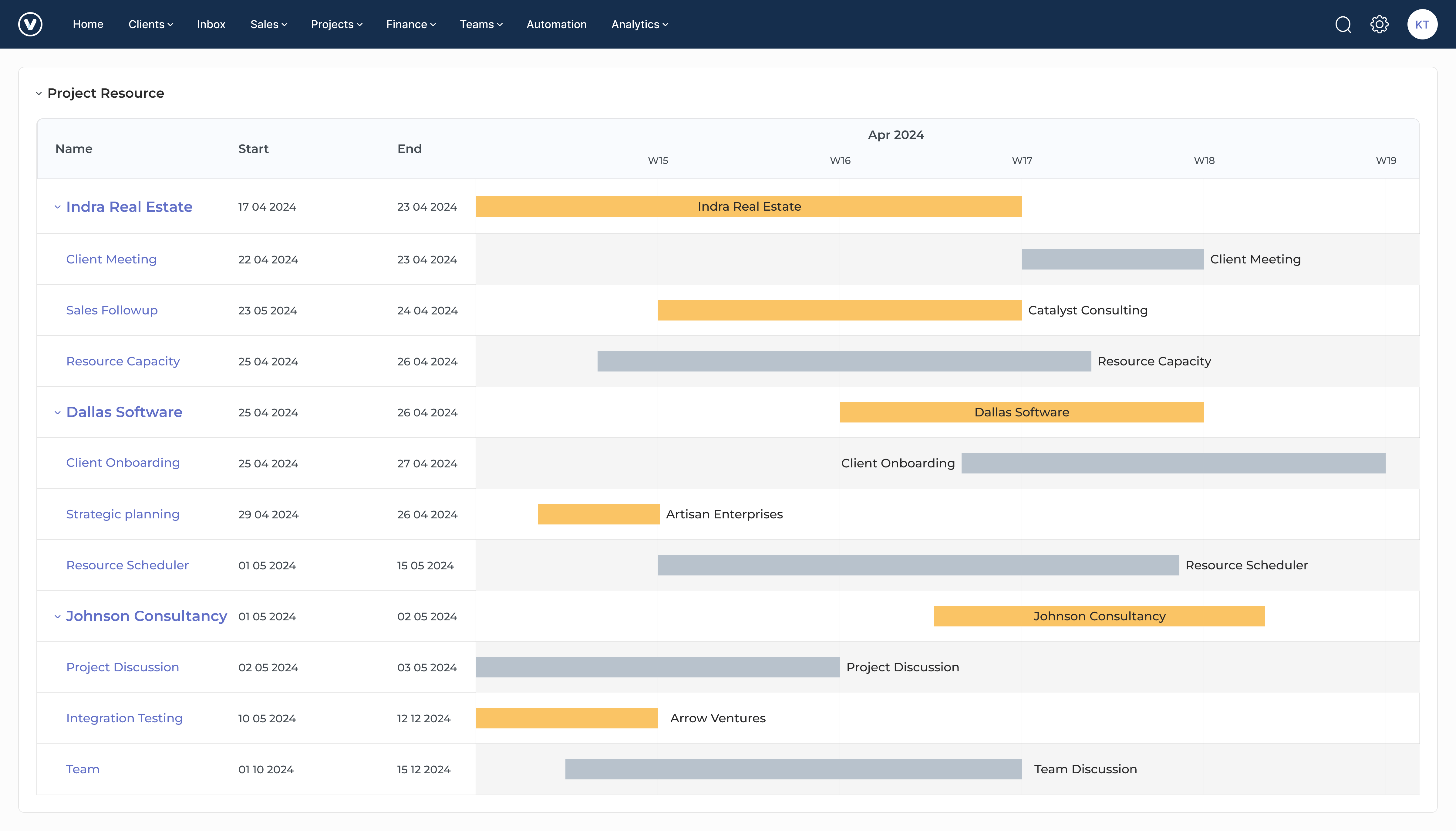What is Capacity Management: Benefits, Examples & Strategies
- What is Capacity Management?
- Why is Capacity Management Important?
- Capacity Management Elements
- How to Build an Effective Capacity Management Strategy
- Top Capacity Management Tools You Should Know
- Challenges Faced During Capacity Management
- Key Agency Capacity Management Metrics
- Harnessing Capacity Management for Business Growth
- FAQs about Capacity Management Process for Professional Services

Key Highlights:
- Effective demand forecasting and skill management ensure adaptability to market changes.
- Key metrics like utilization rate and on-time delivery drive data-driven decision-making.
- Robust capacity management tools streamline resource allocation and enhance team productivity.
Ever feel like your agency’s either running at full throttle or crawling at a snail’s pace?
That’s where capacity management comes in—a behind-the-scenes hero that helps keep everything balanced.
Let’s explore the details of capacity management, breaking down why it’s essential, how to track your team’s bandwidth and tips to keep projects coming along.
Regardless of whether you’re managing a lean crew or a big team with lots of moving parts, a smart capacity strategy is key to keeping your agency productive, profitable, and stress-free.
What is Capacity Management?
Capacity management is the strategic process of planning, analyzing, and optimizing an organization’s resources to meet current as well as future workload demands efficiently.
Capacity management ensures that the right resources are available at the right time, prevents overbooking or underutilization of staff, and enables informed decision-making about growth as well as resource allocation.
Capacity management is really critical in the cases of:
- Project pipeline management: Assessing upcoming projects against current demand as well as resource availability to make informed decisions about taking on new work or adjusting timelines.
- Resource allocation optimization: Identifying skill gaps or excess capacity to inform hiring, training, or reallocation decisions, ensuring balanced workloads across teams.
- Strategic planning and forecasting: Using capacity data to predict future resource needs, plan for expansion, or identify potential bottlenecks in service delivery.
Why is Capacity Management Important?
Without effective capacity management, you risk overloading your team, missing deadlines, or underutilizing valuable resources. Let’s learn why it is important,
Optimizes resource utilization and productivity: Effective capacity management ensures resources are fully utilized without being overloaded. It balances workloads, minimizes idle time, and maximizes productivity, leading to improved efficiency.
Enhances project planning and delivery: With clear visibility into resource availability and skills, firms can accurately plan projects, set realistic time frames as well as allocate appropriate resources.
Supports strategic decision making: Capacity management provides crucial data for informed decision-making about hiring, training, and business development. It helps firms identify growth opportunities, manage risks, and align resources with long-term strategic goals.
Improves financial performance and profitability: By optimizing resource allocation and utilization, capacity management helps maximize billable hours as well as reduce costs associated with under-utilization.
Boost employee satisfaction and retention: Balanced workloads and appropriate skill matching lead to higher employee satisfaction. Effective capacity management prevents burnout, provides growth opportunities, and contributes to better work-life balance, improving retention rates.
Facilitates adaptability to market changes: Robust capacity management enables firms to quickly adapt to changing market conditions and client demands. It provides the flexibility to scale resources up or down as needed, maintaining competitiveness.
Capacity Management Elements
A well-structured capacity management process enables professional services firms to make informed decisions about resource investments, project commitments, and growth strategies.
1. Resource Inventory
Keeping a clear, updated inventory of all your resources is a game-changer. It’s not just about headcount—knowing your team’s skills, experience levels, and specialties gives you a real edge in planning as well as allocation. The more you know about what’s available, the better you can match the right resources to the right projects.
2. Demand Forecasting
Predicting future workload is essential for smooth capacity management. By analyzing historical data, current projects, and market trends, you can get a solid picture of both short-term and long-term demand. Using advanced analytics or AI can make these forecasts even more accurate and reliable.
3. Utilization Tracking
Tracking how efficiently resources are being used gives you a clear view of what’s working and where there’s room to improve. Real-time utilization tracking helps identify potential bottlenecks early, so you can proactively shift resources and keep projects on track without overloading your team.
4. Skill Management
Keeping tabs on your team’s skill set is crucial. Knowing what skills you have, and spotting any gaps, while planning for future needs helps you ensure you have the right talents available to meet client demands, now and down the road.
5. Scenario Planning
Modeling different scenarios lets you explore “what ifs” and see how various changes could impact capacity. This way, you’re ready to make smart choices around resource investments or reallocations, no matter what comes your way.
6. Performance Metrics
Setting and regularly checking key performance metrics is essential. Things like utilization rates, project profitability, on-time delivery, and client satisfaction help you gauge how well your capacity management is working. Regularly reviewing these metrics keeps your processes sharp and your team performing at their best.
How to Build an Effective Capacity Management Strategy
Building an effective capacity management strategy is all about balancing resources to meet current and future demands. Let’s explore how to build an effective strategy.
1. Implement Robust Resource Management Software
Think of resource management software as your one-stop shop for keeping track of who’s doing what and when.
The tool gives real-time visibility into everything from resource allocation to utilization and availability, reducing manual errors while helping you plan more accurately.
Imagine a project where deadlines keep shifting, and roles get swapped at the last minute— capacity planning software can cut through the chaos by automating scheduling, time tracking, as well as reporting.
2. Develop Accurate Demand Forecasting Methods
Accurate demand forecasting can be a lifesaver when it comes to balancing your workload.
By analyzing past data, your current project lineup, and market trends, you get a clearer view of future demand. It helps you staff just the right amount, not too many, not too few.
How to build an effective method, you ask?
- Use a collaborative approach that includes input from sales, operations, and finance.
- Continuously improve your forecasting model by comparing it with actual outcomes.
3. Establish Clear Resource Allocation Processes
Having a clear process for allocating resources keeps things fair, transparent, and efficient.
Instead of scrambling to find someone to fill a role last minute, your team knows exactly how resources are assigned.
A standard system for requests, approvals, and assignments helps eliminate confusion while keeping everyone on the same page.
It requires you to follow a rigorous procedure to get the best results.
- Form a resource allocation committee to make strategic decisions on priority projects.
- Review and adjust allocations regularly to reflect any changes in project needs or resource availability.
4. Create a Skill Matrix and Development Plan
A skill matrix can be a huge help in managing your team’s capabilities. It lets you see at a glance who has which skills and where there may be gaps.
Keep it updated through regular self-assessments and manager validations.
Imagine your agency wants to offer new services—by mapping skills against future needs, you’ll see what training or hiring might be needed. Align development plans with both individual career goals and the agency’s capacity needs.
5. Optimize Project Pipeline Management
Picture a traffic light system for your projects: red means “on hold,” yellow is “starting soon,” and green is “in progress.”
By tracking what’s upcoming and ongoing, you can forecast resource needs more effectively as well as avoid bottlenecks.
Managing your project pipeline well helps prevent both overload and idle time. One of few ways to leverage the benefits of capacity management is through,
- Prioritizing projects based on value, resource needs, and profitability.
- Regularly reviewing to fine-tune your project timelines as well as allocation.
6. Implement Flexible Staffing Models
Flexible staffing is a great way to adapt to changing demands without overcommitting.
You can create a blend of full-time employees, contractors, and strategic partnerships to maintain flexibility.
Do not forget to set clear guidelines for managing flexible resources to ensure consistency.
For instance, if you have a project requiring specialized skills for a few months, hiring a contractor might be more cost-effective than onboarding a new employee.
7. Establish Capacity Metrics
Tracking key performance indicators (KPIs) gives you a snapshot of how well you’re managing capacity.
There are metrics like,
- Utilization rates
- Billable hours
- On-time delivery rates, etc
These help you see where adjustments might be needed. Align KPIs with your agency’s goals so they drive meaningful improvements.
Set up a dashboard to track metrics in real-time and review them regularly for timely adjustments.
8. Conduct Regular Capacity Planning Reviews
Capacity needs change as projects evolve, so regular reviews help keep your plans aligned with real-world demands.
Schedule periodic meetings to go over current capacity, forecasts, and any necessary adjustments. This way, you’re not caught off guard when unexpected projects or staffing needs pop up.
Of course, involving stakeholders gives you a well-rounded view. So, leverage it along with standard procedure to make things run more efficiently.
Top Capacity Management Tools You Should Know
There are different types of capacity management tools available in the market. However, we’ve brought to the best of the list. Let’s explore them right away!
1. Kooper
Kooper is a Professional Service Automation (PSA) software designed with end-to-end client lifecycle management for service-based businesses. The tool offers real-time visibility into team capacity, project progress, and client expectations, enabling efficient project management as well as resource optimization.
Kooper is ideal for consulting firms, agencies, and SaaS companies managing complex client onboarding processes. It helps optimize resource utilization, standardize workflows, and enhance client communication during project kickoffs along with implementations.
Key features:
- Resource forecasting: Provides real-time visibility into team capacity and upcoming resource needs. Enables managers to make data-driven decisions about staffing and project timelines.
- Capacity planning: Offers visual tools to map out resource allocation across multiple projects and timelines. Helps identify potential bottlenecks and optimize workload distribution.
- Time tracking and utilization: Allows team members to log time against specific tasks and projects. Generates detailed utilization reports to identify productivity trends and optimize resource allocation.
- Client portal: Kooper includes a dedicated client portal for transparent communication and collaboration. Clients can access project updates, share files, and provide feedback in real-time.
- Automated workflows: Enables the creation of custom workflows to automate repetitive tasks and approvals. Increases efficiency and ensures consistent project execution across the organization.
- Project templates: Offers customizable templates for common project types, streamlining setup and standardizing processes. Helps maintain consistency across projects and reduces planning time.
- Analytics and reporting: Provides customizable dashboards along with in-depth reports on project performance, resource utilization, and financial metrics. Supports data-driven decision-making and continuous process improvement.
2. Mavenlink
Mavenlink is a comprehensive project management and resource planning platform designed for professional services organizations. It offers real-time visibility into resource utilization, project progress, and financial performance.
Mavenlink provides advanced resource management, project scheduling, time tracking, and financial management capabilities. It offers predictive analytics for capacity planning, customizable dashboards for performance monitoring, and integrations with popular business tools. The platform also includes collaboration features and automated workflow management to streamline operations.
3. Precursive
Precursive is a resource management and capacity planning tool built natively on the Salesforce platform. It’s designed to help professional services organizations optimize resource utilization, streamline project delivery, and improve overall operational efficiency by providing real-time insights into capacity as well as demand.
Precursive offers visual resource scheduling, skills-based resource matching, and capacity forecasting capabilities. It provides real-time utilization reporting, and pipeline management, along with scenario planning tools.
4. Kantata
Kantata is a Professional Services Automation (PSA) solution that focuses on optimizing resource utilization and project profitability. It offers end-to-end visibility into the entire project lifecycle, from sales to delivery, helping organizations manage their capacity effectively.
Kantata provides intelligent resource forecasting, automated resource assignments, and capacity planning tools. It offers real-time analytics, project and pipeline management, time/expense tracking, along with financial management features. The platform also includes scenario modeling capabilities and integrations with CRM as well as accounting systems.
Challenges Faced During Capacity Management
If you think lag strategy is a good option that ensures maximum productivity, think again! There are more challenges if you don’t have a careful plan. Here’s the list to consider.
1. Fluctuating Demand
Unpredictable client demands and market fluctuations make it difficult to maintain optimal capacity. Balancing resources during peak periods without overstaffing during lulls requires constant vigilance and flexibility.
2. Skill Mismatches
As project requirements evolve, aligning available skills with demand becomes challenging. Keeping the workforce’s skill set current and relevant while meeting immediate project needs can create capacity bottlenecks.
3. Resource Hoarding
Project manager often retains top talent even when they’re not fully utilized, fearing future shortages. The practice leads to inefficient resource allocation and missed opportunities for cross-project collaboration.
4. Data Accuracy and Visibility
Maintaining real-time, accurate data on resource availability and utilization across multiple projects as well as departments is complex. Incomplete or outdated information can lead to poor capacity decisions.
5. Long-term vs. Short-term Planning
Balancing immediate project needs with long-term strategic goals presents a significant challenge. Over-focusing on short-term demands can hinder capability development for future growth.
6. Resistance to Change
Implementing new capacity management processes or tools often faces resistance from team members accustomed to traditional ways of working. Overcoming this resistance and ensuring the adoption of new systems can be time-consuming.
Key Agency Capacity Management Metrics
Capacity management metrics when implemented over a period of time, give you accurate numbers to make the right decision. Here are some metrics you should consider,
Utilization rate: The percentage of available time that resources are actively working on billable projects. A high utilization rate indicates efficient resource use, but consistently very high rates may lead to burnout.
Billable hours: The number of hours charged to clients. Tracking billable hours helps measure productivity as well as profitability, and is crucial for accurate invoicing.
Capacity variance: The difference between planned capacity and actual capacity used. A large variance may indicate inaccurate planning or unexpected changes in demand.
Project profitability: The financial return on each project, considering both revenue and costs. Monitoring project profitability helps identify which types of projects or clients are most beneficial for the firm.
On-time delivery rate: The percentage of projects completed within the agreed timeframe. A high on-time delivery rate indicates effective capacity management and contributes to client satisfaction.
Bench time: The amount of time resources spend unallocated or between projects. While some bench time is necessary for flexibility, excessive bench time indicates inefficient capacity management.
Harnessing Capacity Management for Business Growth
Professional service businesses and agencies need to focus on capacity management to maintain profitability as well as achieve predictable resource planning. The proactive approach helps maintain a healthy balance between workload and available resources, leading to improved client satisfaction as well as sustainable growth.
Key takeaways:
- Effective capacity management directly impacts profitability by optimizing resource utilization and preventing revenue leakage.
- Predictable resource planning through capacity management enables better decision-making for future projects and business growth.
- Balancing workload and capacity leads to improved employee satisfaction along with higher-quality deliverables for clients.
Limit time — not creativity
Everything you need for customer support, marketing & sales.
Neeti Singh is a passionate content writer at Kooper, where he transforms complex concepts into clear, engaging and actionable content. With a keen eye for detail and a love for technology, Tushar Joshi crafts blog posts, guides and articles that help readers navigate the fast-evolving world of software solutions.



